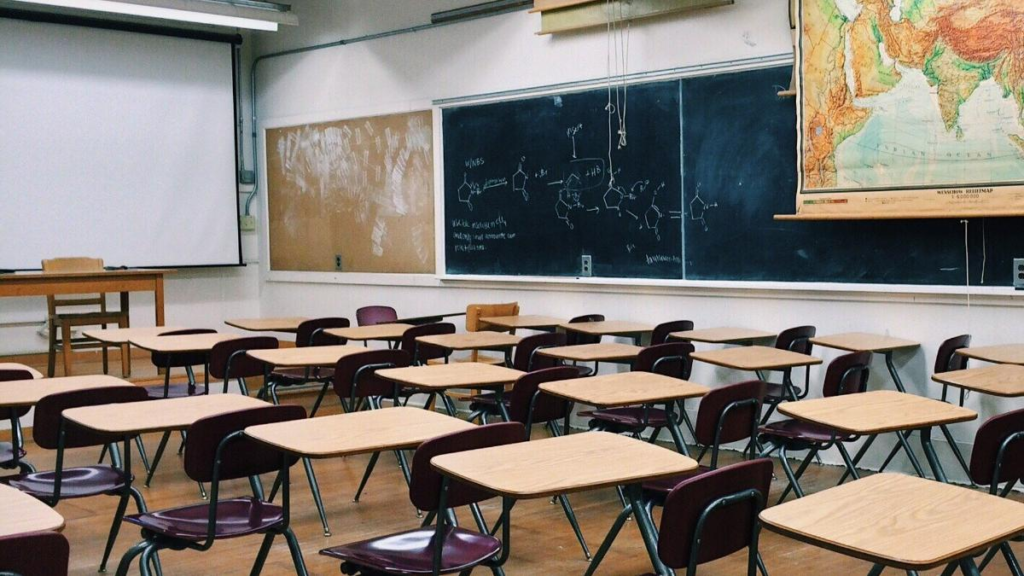School Enrollment Decline Over Two Years, Elementary Level Drops by 8%: Government: School Enrollment is low says the government statistics in Parliament on Thursday. Data revealed a sharp decline in school enrollment across India, particularly at the primary level. Union Minister of State for Tribal Affairs Durgadas Uikey tabled figures before the Lok Sabha indicating that the gross enrollment ratio (GER) of elementary-level tribal students declined shockingly from 103.4% in 2021–2022 to 97.1% in 2023–2024.
School Enrollment Decline Over Two Years
All regions witnessed a significant reduction in their GER as well, from 100.13 percent in 2021–2022 to 91.7% in 2023–2024. The tertiary level also experienced the same declining trend. Tribal students’ GER went down from 78.1% during 2021–2022 to 76.9% during 2023–2024 at the secondary level (classes 9–10), but the GER for all communities’ students declined from 79.56 percent to 77.4 percent during the same period.
At the senior secondary level (classes 11-12), tribal students’ GER fell from 52 percent during 2021-22 to 48.7 percent in 2023-24, and students of all backgrounds fell from 57.56 percent to 56.2%. This trend also appeared more dismal. Congress MP Pramod Tiwari raised concern over the “sharp fall” in school admissions.
He accused financial mismanagement and economic disparity of causing the decline and blamed the Narendra Modi government for not giving high priority to education. Besides concerns regarding shoddy infrastructure and excess students in states such as Telangana, West Bengal, and Punjab, the report also indicated that classrooms were being underutilized in Uttar Pradesh, Madhya Pradesh, and Assam. Tiwari called for urgent government intervention to address these systemic shortcomings and ensure that the futures of students are not further affected by declining enrollment levels.
What is the data showing?
According to the data analyzed by The Student, the ministry said that, in comparison to 2022–2023, there were 28,69,670 fewer students in Uttar Pradesh government schools in classes 1–8 for the 2023–24 academic year. Karnataka (2,82,012), Telangana (2,25,000), Jharkhand (2,23,690), Haryana (1,55,000), Kerala (1,32,941), Madhya Pradesh (1,14,374), and West Bengal (3,70,719) followed.
In addition, in the same period, the ministry highlighted the drop in Himachal Pradesh (21,000), Tripura (15,527), Nagaland (10,000), Mizoram (9,889), and Puducherry (6,236). The drop is the result of “reverse migration” following the COVID-19 pandemic, according to officials in several states. They also noted that children who had shifted from private to public schools due to financial constraints are now returning to private schools.

Private schools and “reverse migration”
With normalcy restored after the pandemic, officials in Uttar Pradesh said the school education department had held the drop in enrollment to students going back to cities with their parents.
The students enrolled in government schools rose by 20–25% in the COVID-19 pandemic period of 2022–2023, when a large number of migratory workers and unemployed people returned to their hometowns. However, most of them returned to the cities once things settled down in 2023, leading to a decrease in the students enrolled in government schools in the state, according to Pradeep Kumar Tiwari, Basic Shiksha Adhikari in Prayagraj.
“Wherever they have shifted, there is still no certainty whether they have taken admission in government or private schools.”
Opposite Effect in Metro Cities?
Experts say that in cities such as Delhi, Jaipur, Noida, and Gurugram, the trend is just the reverse, with a greater number of individuals seeking admission than there are seats for admission in government schools.
Though such schools are the best option for poor, migrant, and marginalized communities, they are ridden with several difficulties, such as poor infrastructure, a high rate of students for every teacher, and a tricky online admission process that ultimately leads to dropouts. Sanjay Gupta, the head of CHETNA, an NGO which strives to educate and empower disadvantaged and marginalized children, said state governments needed to explore the reasons why enrollment in state schools was dipping. “The GNCT (Government of National Capital Territory) of Delhi is urged to improve coverage in relation to enrolment and a report on steps taken should be filed by September 2024,” reads the minutes that The Student had access to.
Just 62 percent of the 1,74,11,532 enrolled children in Uttar Pradesh were provided midday meals during 2023–2024; this was down by 8,46,866 children (7.8%) compared to the preceding year, based on the report. The PAB also suggested that the state government increased the coverage percentages, as these were “below national averages” at the primary and upper primary levels, that is, at 63 percent and 59 percent, respectively. Millions of children across the country may have their lives significantly altered if the PM-POSHAN scheme is properly implemented, experts say.
This scheme can be an important game-changer by providing the right nutrients needed for the optimal brain development of children so that they don’t just survive but really thrive in the educational process,” states Sonal Kapoor, CEO and founder of Protsahan India Foundation, a Delhi-based NGO offering trauma-informed child care to poor children and adolescent girls.
The underutilization of PM-POSHAN, Kapoor emphasized, is a “missed opportunity” to address this pressing issue and enhance the general well-being and educational results of vulnerable groups. “We can significantly impact these children’s lives and help them realize their full potential by utilizing the resources and advantages of the program,” she stated.
Also Read: PIB report for GER
Also Read: IIT placement Slumps